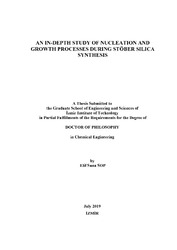Please use this identifier to cite or link to this item:
https://hdl.handle.net/11147/7433Full metadata record
| DC Field | Value | Language |
|---|---|---|
| dc.contributor.advisor | Polat, Mehmet | - |
| dc.contributor.author | Sop, Elif Suna | - |
| dc.date.accessioned | 2019-12-06T11:14:20Z | |
| dc.date.available | 2019-12-06T11:14:20Z | |
| dc.date.issued | 2019-07 | - |
| dc.identifier.citation | Sop, E. S. (2019). An in-depth study of nucleation and growth processes during Stöber silica synthesis. Unpublished doctoral dissertation, Izmir Institute of Technology, Izmir, Turkey | en_US |
| dc.identifier.uri | https://hdl.handle.net/11147/7433 | - |
| dc.description | Thesis (Doctoral)--Izmir Institute of Technology, Chemical Engineering, Izmir, 2019 | en_US |
| dc.description | Includes bibliographical references (leaves: 108-120) | en_US |
| dc.description | Text in English; Abstract: Turkish and English | en_US |
| dc.description.abstract | Silica nanoparticles (SNPs) which can be synthesized with high surface area, controllable morphology and desired particle size have gained significant interests in high-end applications such as catalysis, chemical sensors, cosmetics and drug delivery applications. The sol-gel technique is the most commonly applied method for manufacturing these particles owing to its simplicity and suitability for allowing surface modifications to the final product. Though monodisperse amorphous SNPs have been studied extensively, how their formation proceeds through nucleation and growth is still a topic of debate. Over the years, a number of mathematical models have been suggested for the nucleation and growth of SNPs; some suggesting that silica growth occurred through monomer addition while some arguing that aggregation of nuclei/subparticles were the dominant mechanism. Nevertheless, a clear understanding of the nucleation and growth sub-processes is extremely important in control on the size and shape of SNPs for those industrial applications which demand specific morphology and surface properties. The need for a simple, robust and generalized model, both conceptually and mathematically, to understand formation and growth of Stöber silica particles has been the main driving force for this thesis. In this study, silica synthesis was carried out under a wide variety of experimental conditions while determining the size distributions of the formed particles kinetically during different stages of the synthesis in-situ through SEM analysis using an image analysis software. The outcome of the extensive synthesis work was to obtain a clear understanding of how the formation and growth of the silica particles proceed during synthesis. This conceptual understanding of the nucleation and growth processes was then translated into a mathematical model to predict the size of the particles as a function of synthesis time. | en_US |
| dc.description.abstract | Yüksek yüzey alanları, ayarlanabilir morfolojileri ve istenilen boyutlarda üretilebilmeleri nedeniyle, silika nanotaneler katalizörler, sensörler, kozmetik ürünler ve ilaç taşıyıcılar gibi pek çok yüksek teknoloji uygulamalarında dikkate değer bir ilgi görmektedir. Soljel tekniği, bu tanelerin üretiminde, kolay uygulanabilirliği ve sonuç ürünün niteliklerinin modifikasyonuna olanak vermesi nedeniyle en yaygın kullanılan yöntemdir. Her ne kadar amorf silika taneler sıklıkla çalışılsa da, tanelerin oluşumlarının çekirdeklenme ve büyüme prosesleri ile nasıl ilerlediği sentezin kontrolü ve tekrarlanabilirliği açısından hala bir tartışma konusudur. Yıllar boyunca, sol-jel silika tanelerin çekirdeklenme ve büyüme prosesleri için bir takım matematiksel modeller önerilmiş; kimi silika büyümesinin monomer ilavesi ile olduğunu öne sürmüş kimisi de çekirdek/alt parçacıkların agregasyonun dominant mekanizma olduğunu tartışmıştır. Yine de, çekirdeklenme ve büyüme alt proseslerinin açık bir şekilde anlaşılması, spesifik morfoloji ve yüzey özellikleri gerektiren endüstriyel uygulamalar için silika tanelerin boyut ve morfoloji kontrolü açısıdan son derece önemlidir. Stöber silika tanelerin oluşum ve büyüme mekanizmalarının anlaşılması için konsept ve matematik olarak, basit, sağlam ve genel bir modele olan gereksinim bu tezin temel itici gücüdür. Bu çalışmada, silika sentezi geniş deneysel koşulları altında uygulanmış, oluşan tanelerin boyut dağılımları kinetik olarak sentezin farklı basamaklarında, bir görüntü analiz programı kullanılarak SEM analizlerinden elde edilmiştir. Yoğun sentez çalışmalarının neticesi silika tanelerin sentez esnasında oluşum ve büyüme proseslerinin net bir şekilde anlaşılırlığının sağlanmasıdır. Çekirdeklenme ve büyüme proseslerinin konsept olarak anlaşılması ayrıca sentez zamanına karşı tanelerin boyutunun tahmin edilebilmesine olanak sağlayan bir matematiksel modele aktarılmıştır. | en_US |
| dc.format.extent | xvi, 128 leaves | - |
| dc.language.iso | en | en_US |
| dc.publisher | Izmir Institute of Technology | en_US |
| dc.rights | info:eu-repo/semantics/openAccess | en_US |
| dc.subject | Silica nanoparticles | en_US |
| dc.subject | Stöber silica | en_US |
| dc.subject | Growth mechanism | en_US |
| dc.title | An In-Depth Study of Nucleation and Growth Processes During Stöber Silica Synthesis | en_US |
| dc.title.alternative | Stöber Silika Sentezi Sırasındaki Çekirdeklenme ve Büyüme Proseslerinin Derinlemesine İncelenmesi | en_US |
| dc.type | Doctoral Thesis | en_US |
| dc.institutionauthor | Sop, Elif Suna | - |
| dc.department | Thesis (Doctoral)--İzmir Institute of Technology, Chemical Engineering | en_US |
| dc.relation.publicationcategory | Tez | en_US |
| dc.identifier.wosquality | N/A | - |
| dc.identifier.scopusquality | N/A | - |
| item.openairecristype | http://purl.org/coar/resource_type/c_18cf | - |
| item.languageiso639-1 | en | - |
| item.openairetype | Doctoral Thesis | - |
| item.grantfulltext | open | - |
| item.fulltext | With Fulltext | - |
| item.cerifentitytype | Publications | - |
| Appears in Collections: | Phd Degree / Doktora | |
Files in This Item:
| File | Description | Size | Format | |
|---|---|---|---|---|
| T001936.pdf | DoctoralThesis | 12.6 MB | Adobe PDF |  View/Open |
CORE Recommender
Page view(s)
522
checked on Mar 31, 2025
Download(s)
510
checked on Mar 31, 2025
Google ScholarTM
Check
Items in GCRIS Repository are protected by copyright, with all rights reserved, unless otherwise indicated.